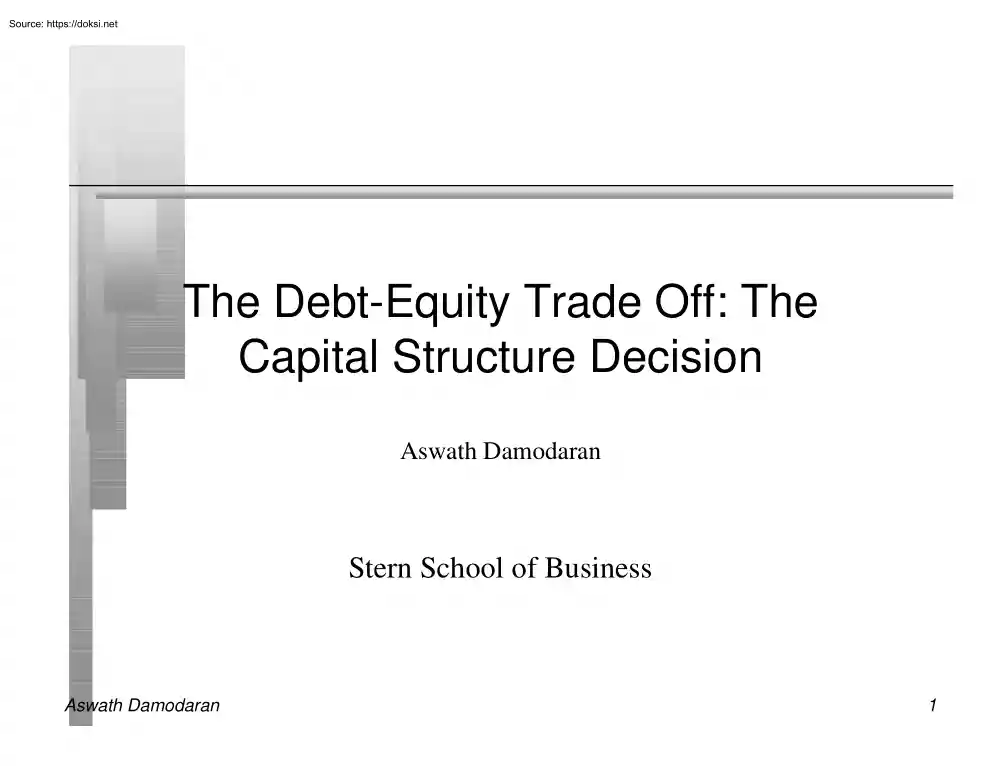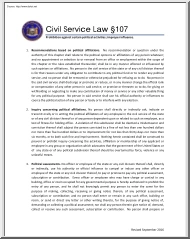A doksi online olvasásához kérlek jelentkezz be!

A doksi online olvasásához kérlek jelentkezz be!
Nincs még értékelés. Legyél Te az első!
Mit olvastak a többiek, ha ezzel végeztek?
Tartalmi kivonat
The Debt-Equity Trade Off: The Capital Structure Decision Aswath Damodaran Stern School of Business Aswath Damodaran 1 First Principles n Invest in projects that yield a return greater than the minimum acceptable hurdle rate. • The hurdle rate should be higher for riskier projects and reflect the financing mix used - owners’ funds (equity) or borrowed money (debt) • Returns on projects should be measured based on cash flows generated and the timing of these cash flows; they should also consider both positive and negative side effects of these projects. n n Choose a financing mix that minimizes the hurdle rate and matches the assets being financed. If there are not enough investments that earn the hurdle rate, return the cash to stockholders. • Aswath Damodaran The form of returns - dividends and stock buybacks - will depend upon the stockholders’ characteristics. 2 The Agenda n n n n What is debt? What determines the optimal mix of debt and equity for a
company? How does altering the mix of debt and equity affect investment analysis and value at a company? What is the right kind of debt for a company? Aswath Damodaran 3 What is debt. n General Rule: Debt generally has the following characteristics: • Commitment to make fixed payments in the future • The fixed payments are tax deductible • Failure to make the payments can lead to either default or loss of control of the firm to the party to whom payments are due. Aswath Damodaran 4 What would you include in debt? n n Any interest-bearing liability, whether short term or long term. Any lease obligation, whether operating or capital. Aswath Damodaran 5 Converting Operating Leases to Debt n n The “debt value” of operating leases is the present value of the lease payments, at a rate that reflects their risk. In general, this rate will be close to or equal to the rate at which the company can borrow. Aswath Damodaran 6 Operating Leases at The Gap n
n n n Operating lease expenses in 1995 = $304.6 million Cost of Debt in 1995 = 7.30% Duration of Lease Obligations = 12 yrs PV of Lease Expenses = $304.6 million for 12 years at 730% = $2,381 million Aswath Damodaran 7 Measuring Financial Leverage n Two variants of debt ratio • Debt to Capital Ratio = Debt / (Debt + Equity) • Debt to Equity Ratio = Debt / Equity n n Ratios can be based only on long term debt or total debt. Ratios can be based upon book value or market value. Aswath Damodaran 8 Costs and Benefits of Debt n Benefits of Debt • Tax Benefits • Adds discipline to management n Costs of Debt • Bankruptcy Costs • Agency Costs • Loss of Future Flexibility Aswath Damodaran 9 Tax Benefits of Debt n (a) Tax Benefits: Interest on debt is tax deductible whereas cashflows on equity (like dividends) are not. • Tax benefit each year = t r B • After tax interest rate of debt = (1-t) r n Proposition 1: Other things being equal, the higher
the marginal tax rate of a corporation, the more debt it will have in its capital structure. Aswath Damodaran 10 Issue 1: The Effects of Taxes 1. You are comparing the debt ratios of real estate corporations, which pay the corporate tax rate, and real estate investment trusts, which are not taxed, but are required to pay 95% of their earnings as dividends to their stockholders. Which of these two groups would you expect to have the higher debt ratios? ❒ The real estate corporations ❒ The real estate investment trusts ❒ Cannot tell, without more information Aswath Damodaran 11 Debt adds discipline to management n n Equity is a cushion; Debt is a sword; The management of firms which have high cashflows left over each year are more likely to be complacent and inefficient. Aswath Damodaran 12 Issue 2: Debt and Discipline 2. Assume that you buy into this argument that debt adds discipline to management. Which of the following types of companies will most benefit
from debt adding this discipline? ❒ Conservatively financed, privately owned businesses ❒ Conservatively financed, publicly traded companies, with a wide and diverse stock holding ❒ Conservatively financed, publicly traded companies, with an activist and primarily institutional holding. Aswath Damodaran 13 Bankruptcy Cost n The expected bankruptcy cost is a function of two variables-• the cost of going bankrupt – direct costs: Legal and other Deadweight Costs – indirect costs: Lost Sales. • durable versus non-durable goods (cars) • quality/safety is important (airlines) • supplementary services (copiers) • the probability of bankruptcy Aswath Damodaran 14 The Bankruptcy Cost Proposition n Proposition 2: Other things being equal, the greater the implicit bankruptcy cost and/or probability of bankruptcy in the operating cashflows of the firm, the less debt the firm can afford to use. Aswath Damodaran 15 Issue 3 : Debt & Bankruptcy Cost 3.
Rank the following companies on the magnitude of bankruptcy costs from most to least, taking into account both explicit and implicit costs: ❒ A Grocery Store ❒ An Airplane Manufacturer ❒ High Technology company Aswath Damodaran 16 Agency Cost n Stockholders incentives are different from bondholder incentives • Taking of Risky Projects • Paying large dividends n Proposition 3: Other things being equal, the greater the agency problems associated with lending to a firm, the less debt the firm can afford to use. Aswath Damodaran 17 Loss of future financing flexibility n n When a firm borrows up to its capacity, it loses the flexibility of financing future projects with debt. Proposition 4: Other things remaining equal, the more uncertain a firm is about its future financing requirements and projects, the less debt the firm will use for financing current projects. Aswath Damodaran 18 Relative Importance Of Financing Planning Principles Aswath Damodaran
19 Debt: A Balance Sheet Format Advantages of Borrowing Disadvantages of Borrowing 1. Tax Benefit: 1. Bankruptcy Cost: Higher tax rates --> Higher tax benefit Higher business risk --> Higher Cost 2. Added Discipline: 2. Agency Cost: Greater the separation between managers Greater the separation between stock- and stockholders --> Greater the benefit holders & lenders --> Higher Cost 3. Loss of Future Financing Flexibility: Greater the uncertainty about future financing needs --> Higher Cost Aswath Damodaran 20 A Hypothetical Scenario n Assume you operate in an environment, where • • • • • Aswath Damodaran (a) there are no taxes (b) there is no separation between stockholders and managers. (c) there is no default risk (d) there is no separation between stockholders and bondholders (e) firms know their future financing needs 21 The Miller-Modigliani Theorem n n In an environment, where there are no taxes, default risk or
agency costs, capital structure is irrelevant. The value of a firm is independent of its debt ratio. Aswath Damodaran 22 Implications of MM Theorem (a) Leverage is irrelevant. A firm's value will be determined by its project cash flows. (b) The cost of capital of the firm will not change with leverage. As a firm increases its leverage, the cost of equity will increase just enough to offset any gains to the leverage Aswath Damodaran 23 What do firms look at in financing? n n A. Is there a financing hierarchy? Argument: • There are some who argue that firms follow a financing hierarchy, with retained earnings being the most preferred choice for financing, followed by debt and that new equity is the least preferred choice. Aswath Damodaran 24 Rationale for Financing Hierarchy n n Managers value flexibility. External financing reduces flexibility more than internal financing. Managers value control. Issuing new equity weakens control and new debt creates bond
covenants. Aswath Damodaran 25 Preference rankings long-term finance: Results of a survey Ranking Source Score 1 Retained Earnings 5.61 2 Straight Debt 4.88 3 Convertible Debt 3.02 4 External Common Equity 2.42 5 Straight Preferred Stock 2.22 6 Convertible Preferred 1.72 Aswath Damodaran 26 Issue 5: Financing Choices 5. You are reading the Wall Street Journal and notice a tombstone ad for a company, offering to sell convertible preferred stock. What would you hypothesize about the health of the company issuing these securities? ❒ Nothing ❒ Healthier than the average firm ❒ In much more financial trouble than the average firm Aswath Damodaran 27
company? How does altering the mix of debt and equity affect investment analysis and value at a company? What is the right kind of debt for a company? Aswath Damodaran 3 What is debt. n General Rule: Debt generally has the following characteristics: • Commitment to make fixed payments in the future • The fixed payments are tax deductible • Failure to make the payments can lead to either default or loss of control of the firm to the party to whom payments are due. Aswath Damodaran 4 What would you include in debt? n n Any interest-bearing liability, whether short term or long term. Any lease obligation, whether operating or capital. Aswath Damodaran 5 Converting Operating Leases to Debt n n The “debt value” of operating leases is the present value of the lease payments, at a rate that reflects their risk. In general, this rate will be close to or equal to the rate at which the company can borrow. Aswath Damodaran 6 Operating Leases at The Gap n
n n n Operating lease expenses in 1995 = $304.6 million Cost of Debt in 1995 = 7.30% Duration of Lease Obligations = 12 yrs PV of Lease Expenses = $304.6 million for 12 years at 730% = $2,381 million Aswath Damodaran 7 Measuring Financial Leverage n Two variants of debt ratio • Debt to Capital Ratio = Debt / (Debt + Equity) • Debt to Equity Ratio = Debt / Equity n n Ratios can be based only on long term debt or total debt. Ratios can be based upon book value or market value. Aswath Damodaran 8 Costs and Benefits of Debt n Benefits of Debt • Tax Benefits • Adds discipline to management n Costs of Debt • Bankruptcy Costs • Agency Costs • Loss of Future Flexibility Aswath Damodaran 9 Tax Benefits of Debt n (a) Tax Benefits: Interest on debt is tax deductible whereas cashflows on equity (like dividends) are not. • Tax benefit each year = t r B • After tax interest rate of debt = (1-t) r n Proposition 1: Other things being equal, the higher
the marginal tax rate of a corporation, the more debt it will have in its capital structure. Aswath Damodaran 10 Issue 1: The Effects of Taxes 1. You are comparing the debt ratios of real estate corporations, which pay the corporate tax rate, and real estate investment trusts, which are not taxed, but are required to pay 95% of their earnings as dividends to their stockholders. Which of these two groups would you expect to have the higher debt ratios? ❒ The real estate corporations ❒ The real estate investment trusts ❒ Cannot tell, without more information Aswath Damodaran 11 Debt adds discipline to management n n Equity is a cushion; Debt is a sword; The management of firms which have high cashflows left over each year are more likely to be complacent and inefficient. Aswath Damodaran 12 Issue 2: Debt and Discipline 2. Assume that you buy into this argument that debt adds discipline to management. Which of the following types of companies will most benefit
from debt adding this discipline? ❒ Conservatively financed, privately owned businesses ❒ Conservatively financed, publicly traded companies, with a wide and diverse stock holding ❒ Conservatively financed, publicly traded companies, with an activist and primarily institutional holding. Aswath Damodaran 13 Bankruptcy Cost n The expected bankruptcy cost is a function of two variables-• the cost of going bankrupt – direct costs: Legal and other Deadweight Costs – indirect costs: Lost Sales. • durable versus non-durable goods (cars) • quality/safety is important (airlines) • supplementary services (copiers) • the probability of bankruptcy Aswath Damodaran 14 The Bankruptcy Cost Proposition n Proposition 2: Other things being equal, the greater the implicit bankruptcy cost and/or probability of bankruptcy in the operating cashflows of the firm, the less debt the firm can afford to use. Aswath Damodaran 15 Issue 3 : Debt & Bankruptcy Cost 3.
Rank the following companies on the magnitude of bankruptcy costs from most to least, taking into account both explicit and implicit costs: ❒ A Grocery Store ❒ An Airplane Manufacturer ❒ High Technology company Aswath Damodaran 16 Agency Cost n Stockholders incentives are different from bondholder incentives • Taking of Risky Projects • Paying large dividends n Proposition 3: Other things being equal, the greater the agency problems associated with lending to a firm, the less debt the firm can afford to use. Aswath Damodaran 17 Loss of future financing flexibility n n When a firm borrows up to its capacity, it loses the flexibility of financing future projects with debt. Proposition 4: Other things remaining equal, the more uncertain a firm is about its future financing requirements and projects, the less debt the firm will use for financing current projects. Aswath Damodaran 18 Relative Importance Of Financing Planning Principles Aswath Damodaran
19 Debt: A Balance Sheet Format Advantages of Borrowing Disadvantages of Borrowing 1. Tax Benefit: 1. Bankruptcy Cost: Higher tax rates --> Higher tax benefit Higher business risk --> Higher Cost 2. Added Discipline: 2. Agency Cost: Greater the separation between managers Greater the separation between stock- and stockholders --> Greater the benefit holders & lenders --> Higher Cost 3. Loss of Future Financing Flexibility: Greater the uncertainty about future financing needs --> Higher Cost Aswath Damodaran 20 A Hypothetical Scenario n Assume you operate in an environment, where • • • • • Aswath Damodaran (a) there are no taxes (b) there is no separation between stockholders and managers. (c) there is no default risk (d) there is no separation between stockholders and bondholders (e) firms know their future financing needs 21 The Miller-Modigliani Theorem n n In an environment, where there are no taxes, default risk or
agency costs, capital structure is irrelevant. The value of a firm is independent of its debt ratio. Aswath Damodaran 22 Implications of MM Theorem (a) Leverage is irrelevant. A firm's value will be determined by its project cash flows. (b) The cost of capital of the firm will not change with leverage. As a firm increases its leverage, the cost of equity will increase just enough to offset any gains to the leverage Aswath Damodaran 23 What do firms look at in financing? n n A. Is there a financing hierarchy? Argument: • There are some who argue that firms follow a financing hierarchy, with retained earnings being the most preferred choice for financing, followed by debt and that new equity is the least preferred choice. Aswath Damodaran 24 Rationale for Financing Hierarchy n n Managers value flexibility. External financing reduces flexibility more than internal financing. Managers value control. Issuing new equity weakens control and new debt creates bond
covenants. Aswath Damodaran 25 Preference rankings long-term finance: Results of a survey Ranking Source Score 1 Retained Earnings 5.61 2 Straight Debt 4.88 3 Convertible Debt 3.02 4 External Common Equity 2.42 5 Straight Preferred Stock 2.22 6 Convertible Preferred 1.72 Aswath Damodaran 26 Issue 5: Financing Choices 5. You are reading the Wall Street Journal and notice a tombstone ad for a company, offering to sell convertible preferred stock. What would you hypothesize about the health of the company issuing these securities? ❒ Nothing ❒ Healthier than the average firm ❒ In much more financial trouble than the average firm Aswath Damodaran 27




